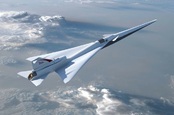This article is more than 1 year old
NASA building network cables that can survive supersonic flight - could this finally deliver unbreakable RJ45 latching tabs?
Needed for probe testing how X-59 can break sound barrier without breaking eardrums
NASA has revealed it’s building network cables capable of surviving supersonic flight.
The cables are needed for a project called “SCHAMROQ” – aka Schlieren, Airborne Measurements, and Range Operations for QueSST.
Keen-minded Reg readers will recall that QueSST is NASA’s attempt to create a new supersonic jetliner, code-named the X-59, that doesn’t make a deafening sonic boom.
SCHAMROQ is the project that will build the instruments used to measure the X-59’s audio output. Those instruments will fly on an F-15 aircraft that follows X-59 test flights so will need to survive supersonic flight and the X-59’s shockwave.
NASA deputy instrumentation lead Matthew Waldersen said part of the testing process requires the usage of a network switch with cables, which NASA has described as “similar to an ethernet network, but for airplanes.”
Armstrong Flight Research Center in California oversees the X-59, but Kennedy Space Centre in Florida got the job of building the cables.
The space agency hasn't said why it needs special cables for the job or the qualities they'll need to survive this gig. But NASA’s branch chief of testing and design in Kennedy Space Center Engineering, Jeff Crisafulli, said the base has just the right people to build these very fast cables.
“These are highly skilled technicians, with 25-30 years of experience fabricating and designing, the NASA way,” Crisafulli said. “They’re considered part of the team.”
The planes chasing the X-59 will use an instrument called the “Shock Sensing Probe” which NASA says will employ “a schlieren photography technique to visualize the X-59's shockwaves as they distort light through a camera”.
The Register imagines that these cables will need to deal with lots of vibration and heat, plus changes in temperature. And what's the most vulnerable part of any cable? The RJ45 latching tab! Readers will be aware that many NASA projects have produced spin-offs that have applications outside of the aerospace industry. If NASA can fix latching tabs, that will be a worthy innovation! ®

